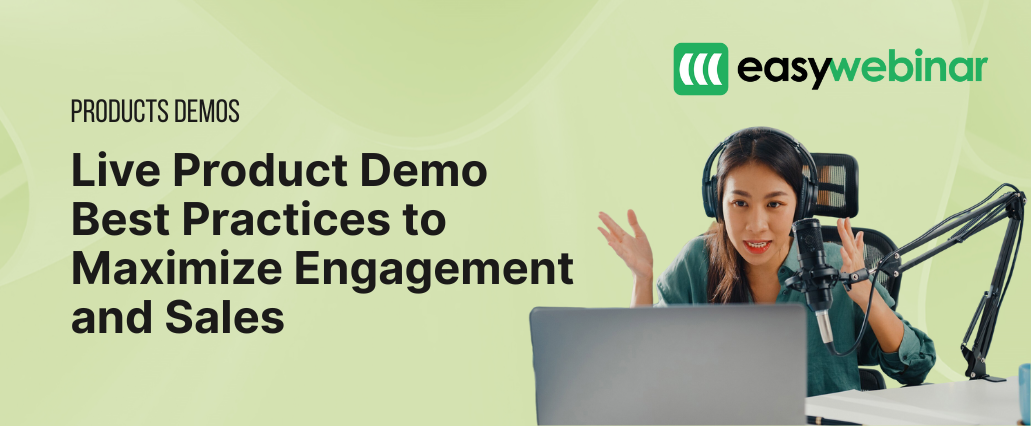Products Demos: Live Product Demo Best Practices to Maximize Engagement and Sales

Summary :
Product demos have become one of the most effective sales tools for showcasing real-world value and driving conversions. This guide explores how to design live and interactive product demonstrations that captivate audiences, highlight benefits, and turn interest into action. Learn storytelling techniques, discover how to use EasyWebinar for interactive demos, avoid common mistakes like feature overload, and apply post-demo follow-up strategies that convert prospects into loyal customers.
Table of Contents
- Interactive Product Demos That Drive Engagement
- Common Mistakes to Avoid in Product Demos
- Post-Demo Strategies to Maximize Conversions
- Conclusion
- FAQs
A staggering 94% of customers feel more confident about their purchase after watching product videos during the sales process.
Simple changes make big differences. Replacing “Request a Demo” with “Watch a Demo” on your button can help you attract product-qualified leads at 4X the rate of standard landing pages. Product demos serve as powerful sales tools that show your solution at work and help potential customers see how your product solves their specific problems.
Product demonstrations go beyond feature highlights. These demos give you a chance to tell a compelling story that appeals to your prospects’ pain points. Your interactive product demos can be especially powerful when you have embedded demos in feature launches, achieving an impressive 68.24% engagement rate. On top of that, these individual-specific experiences reach a 48.97% completion rate on landing pages.
The right product demos create clear value for your sales process and customers alike. Your prospects can see themselves using the product to solve their challenges and achieve their goals. A compelling demo presentation with a clear call-to-action can boost your conversions by up to 161%.
This piece will help you become skilled at creating engaging product demos that deliver real results and maximize your sales potential.
The Role of Product Demos in Modern Sales
B2B sales teams only get 5% of a customer’s total purchase time. This small window makes every interaction count. Product demos have grown beyond simple feature presentations into strategic tools that affect buying decisions. Companies now call them a top factor in their final purchase decisions 54% of the time.
Why demos are more than feature showcases
Product demos have changed from basic feature-focused presentations to powerful storytelling tools. Good demos don’t just show capabilities – they solve specific customer problems and show real solutions. Research proves that teaching customers something new about their business needs changes their buying direction.
Today’s demos create emotional connections with prospects. They show how your product solves real-life problems that customers face every day. This helps viewers see themselves using your solution. Interactive demos get three times more engagement than standard video demos.
The difference between old and new demo styles is clear. Bad demos only talk about product features, while exceptional ones focus on customer problems. This customer-first approach works better, especially since Gartner’s research shows that customers don’t value sellers in traditional interactions.
How demos reduce friction in the buyer’s trip
Product demos make the buying process smoother. Prospects can try your solution firsthand without any commitment. They can explore on their own instead of waiting for sales calls. Interactive product tours have boosted website interactions that turn into leads by 60%.
Buying decisions today need multiple stakeholders in a committee. Interactive demos help these committees review products even without final sales meetings. Prospects who try virtual demos are 50% more likely to become sales-ready compared to those who only look at traditional content.
Customers who see how your product fixes their specific needs build trust before purchase. This reduces their worry about making wrong choices. Demos verify your claims as a solution provider. The hands-on approach grabs attention and builds product confidence, which cuts sales cycles by about two weeks.
Companies that use effective demo strategies see benefits across their sales pipeline. These businesses get 15% more marketing qualified leads and up to 20% growth in upper funnel volume. Interactive product demos meet buyers where they are, giving them information they need without pressure.
Crafting a Compelling Product Demo Presentation
A great product demo builds confidence and enthusiasm by showing audiences exactly what they’ll get. An effective product demonstration turns technical capabilities into a story that appeals to potential customers.
Create a narrative around the customer’s pain point
The best product demos start with a deep understanding of your audience’s challenges. Research your prospect’s needs and tailor your demonstration to address their specific problems before creating your presentation.
Your demo becomes powerful when you establish contrast between “before” and “after” states. Start with your customer’s challenges without your solution, then show how your product changes their experience. An expert notes, “This means we need to foresee life without our products and then show the improvement our products make possible”. The contrast becomes vital because “our demo’s finish will only be as delightful as our beginning was painful”.
The gap between problem and solution needs connecting phrases like “because,” “therefore,” and “but.” Your audience will follow the logical progression better. This narrative approach turns your demo products from a feature showcase into a story of transformation.
Use visuals and storytelling to drive engagement
The human brain processes visuals faster than text. Visual elements become essential parts of your product demo presentation. Your demo should include compelling visuals that illustrate key points, simplify complex ideas, and keep your audience focused.
Your demonstration becomes more effective with a three-act storytelling framework:
- Beginning: Introduce the character (your customer) and their challenge
- Middle: Present the conflict or pain point in detail
- End: Demonstrate how your product resolves the issue
Companies that utilize storytelling in their presentations achieve 62% greater productivity and 50% better retention of information. Stories with real-life problem-solving help prospects see themselves using your product successfully.
Screen recordings, annotated screenshots, and visual aids guide your viewer’s attention to important elements. One expert suggests: “I use the phrase, ‘Here you’re looking at…’ to hammer that home”. This approach helps audiences connect your narration with what they see.
Avoid jargon and keep messaging clear
Jargon creates barriers and alienates your audience. Studies show 83% of senior marketing professionals believe excess jargon adds unnecessary complexity. Your audience’s knowledge level should determine your language choice since jargon varies by experience.
Simple and conversational messaging works best:
- Write the way you talk naturally
- Use short words, sentences, and paragraphs
- Explain technical terms in plain language
- Focus on benefits rather than technical specifications
Feature descriptions need a “visualization test.” Each word in your sentences should have clear visual counterparts. Words like “solution,” “synergy,” or “utilize” fail this test. These terms lack visual meaning and become forgettable.
Your goal should focus on creating clarity and confidence rather than showing technical expertise. Simple storytelling in your interactive product demos creates presentations that appeal to prospects and drive purchase decisions.

Interactive Product Demos That Drive Engagement
Modern buyers expect more than just static presentations, they want immersive, hands-on experiences that show how your solution works in real life. Interactive product demos turn passive viewers into active participants, helping them connect your product’s value to their own needs.
Let users explore features hands-on
Interactive product demos let prospects explore your product at their own pace through self-guided or on-demand experiences. Instead of one-on-one sessions, you can use Simulive or evergreen webinars inside EasyWebinar to run pre-recorded demos that look and feel live, complete with audience chat, polls, and real-time offers. This approach scales your product demonstrations while maintaining a personal, engaging feel.
Studies show that interactive, self-directed demos can dramatically improve engagement. Prospects who view multiple demos are more likely to convert, and shorter, focused walkthroughs (2–3 minutes) showcasing key “aha” moments tend to perform best. These demos reduce friction in the buying process by letting leads discover the features most relevant to them.
Use EasyWebinar to embed interactive elements
EasyWebinar makes it simple to deliver both live and automated demo sessions that engage prospects across time zones. You can schedule Simulive webinars to blend live interaction with pre-recorded demos or use evergreen webinars that run on autopilot around the clock.
Here’s how EasyWebinar boosts demo engagement:
- Real-time chat and Q&A let audiences ask questions as if it were a live session.
- Interactive polls keep attention high and help you understand user priorities.
- Push offers with CTAs and countdowns encourage immediate action during or after demos.
- Just-in-Time scheduling runs demos in 15, 30, 45 minutes, or 1-hour intervals, giving prospects instant access without waiting for the next live slot.
This balance of automation and interactivity ensures your demos reach more people, stay consistently engaging, and fit any buyer’s schedule.
Track engagement to understand audience behavior
EasyWebinar’s analytics dashboard provides valuable engagement data that helps you qualify leads. You can track:
- Registration and attendance rates
- Poll participation
- Chat activity and offer clicks
- Drop-off and replay viewing patterns
These insights show how long attendees stayed, what features caught their attention, and which demos they rewatched, all of which signal interest levels and buyer intent. You can then sync these behavioral insights with your CRM through EasyWebinar’s integrations to tailor follow-ups that reference what viewers interacted with most.
By analyzing engagement patterns, your team can identify which demos resonate best and optimize future sessions for stronger performance.
Common Mistakes to Avoid in Product Demos
Product demos can fall flat despite their sophistication when critical errors occur. Research shows that 66% of consumers prefer self-guided product demos over face-to-face sessions. Many companies still make basic mistakes that reduce their effectiveness.
Overloading with features
Overwhelming prospects with too many features creates a major pitfall. Research indicates that feature-heavy demos confuse potential customers. This approach doesn’t impress buyers and often pushes them away.
Dumping features shows a misunderstanding of customer needs. Prospects want to see how your product demonstration solves their specific problems. This is just a part of what your product can do. Your demos should show how key features tackle real challenges instead of displaying every function.
Skipping discovery and personalization
Sales engineers don’t get enough information to create demos that work between 50-74% of the time when they’re not part of the discovery process. Your demo products might miss what matters most to prospects without proper discovery.
Discovery helps spot potential roadblocks or objections during the sales process. Sales teams that take time for discovery before their demo win 73% more often than those who skip it. Moving straight to the demo without understanding customer needs creates problems.
Lack of follow-up or next steps
A promising product demo presentation can fail without proper follow-up. You rarely close deals during a demo—a quick, tailored follow-up is vital.
Reach out within 24 working hours of your first sales demo meeting. Quick follow-up shows your dedication and keeps your solution fresh in mind. Your follow-up should include:
- A concise summary of key takeaways
- Clear next steps with specific timeframes
- Relevant resources addressing prospects’ main concerns
- Customer testimonials from similar industries
Post-demo engagement needs continuous and strategic attention to keep prospects interested. Each interaction should add real value. This positions you as a trusted advisor rather than another salesperson.
Post-Demo Strategies to Maximize Conversions
Your product demonstration’s completion marks the beginning of your conversion potential. The actions you take next will determine whether interested viewers become paying customers.
Send demo recordings via Easywebinar
EasyWebinar lets you record your live product demo webinars automatically and turn them into replays or on-demand sessions without any manual setup. Anyone who missed the live event, left early, or wants to revisit the session can access the full replay instantly. You can also send replay links directly via email to keep your audience engaged beyond the live presentation.
Best practice: Send replay access within 24 hours of the live demo. Attendance and engagement rates peak when your follow-up is quick and timely, ensuring the session remains fresh in attendees’ minds.
Segment Your Follow-Ups
Not every registrant interacts the same way during your demo. EasyWebinar makes it simple to tag and track audience segments based on their behavior, so you can tailor your follow-up messaging more effectively.
Typical segments include:
- Attendees who stayed until the offer – highly engaged, ready for next steps.
- Early leavers – interested but may need more clarity or reminders.
- No-shows – registered but never attended.
- Replay viewers – those who engage after the live event.
This segmentation enables personalized communication that drives higher engagement. For example, you can send trial offers to highly engaged attendees, reminders or replays to no-shows, or educational content to those who left early.
Follow Up with Tailored CTAs
Generic “Book a demo” or “Learn more” links rarely perform well. EasyWebinar allows you to include timed offers and custom CTAs inside both live and replay sessions, ensuring prospects take the right next step at the right time.
Here are a few examples based on audience type:
- Qualified leads: Free trial access, pricing breakdowns, or “Book a 1:1 call.”
- Earlier-stage prospects: Case studies, feature guides, or use-case walkthroughs.
- Skeptical or stalled leads: Customer testimonials, ROI calculators, or “See how others in your industry succeeded.”
What to Include in Replay Follow-Ups
Every replay follow-up email should have a clear, action-oriented structure. Include:
- Next steps and deadlines – e.g., “Book your trial this week to access bonus features.”
- Helpful resources – address objections with content like integration FAQs or security documentation.
- Proof points – highlight success stories, testimonials, or case studies specific to the prospect’s industry.
By pairing EasyWebinar’s automation with personalized, timely follow-ups, you can transform a single demo event into a continuous lead-nurturing engine that builds trust and accelerates conversions.

Conclusion
Product demos have evolved beyond simple feature presentations into powerful conversion tools that can revolutionize your sales process. This piece shows how effective demonstrations build customer confidence. Studies show that 94% of buyers say product videos boost their purchasing confidence.
Your demos should focus on solving customer problems instead of bombarding prospects with endless features. The presentations need to weave a compelling story around the customer’s pain point. This approach creates a clear contrast between their challenges and your solution. Prospects can better picture themselves using your product when benefits become tangible and relatable.
On top of that, interactive elements boost engagement significantly. Embedded demos achieve a remarkable 68.24% engagement rate during feature launches. EasyWebinar’s platform helps you make the most of this chance. The platform provides both live and pre-recorded demo options with interactive features. Real-time chat and polls keep your audience actively involved.
The follow-up strategy carries equal weight once the demo ends. Quick delivery of recordings, personalized calls-to-action based on prospect behavior, and continuous refinement using viewer feedback are crucial. These post-demo actions often determine if interested viewers become paying customers.
Product demos are fundamentally about building relationships, not just displaying technology. Demos become powerful tools that target specific customer needs when you avoid common pitfalls like feature overload and poor discovery. The numbers tell the story – companies using effective demo strategies see up to 20% growth in upper funnel volume and can boost conversions by an impressive 161%.
Are you ready to turn your product demonstrations into conversion machines? These best practices can help your engagement metrics and sales opportunities grow. Your prospects want to see how you’ll solve their problems – show them with a demo that strikes a chord.
FAQs
Q1. What are the key elements of an effective product demonstration?
An effective product demonstration focuses on solving customer problems rather than overwhelming prospects with features. It creates a compelling narrative around the customer’s pain points, uses visuals and storytelling to drive engagement, and avoids technical jargon. Interactive elements and personalization based on the audience’s needs also significantly enhance the demo’s effectiveness.
Q2. How can I prepare for a successful product demo?
To prepare for a successful product demo, research your audience thoroughly and tailor the presentation to their specific needs. Create user stories to guide your demo, focusing on how your product solves real-world problems. Ask questions in advance to understand the prospect’s main pain points, and craft your demo around addressing these issues. Keep the presentation engaging by encouraging questions and providing clear, relatable examples.
Q3. What common mistakes should be avoided during a product demonstration?
Common mistakes to avoid include overloading the demo with too many features, skipping the discovery process and personalization, and failing to follow up after the demo. It’s crucial to focus on demonstrating how key features address specific challenges rather than showcasing every function. Additionally, rushing into a demo without understanding customer needs can significantly reduce your chances of success.
Q4. How do interactive demos enhance the sales process?
Interactive demos enhance the sales process by allowing prospects to experience the product firsthand, increasing engagement and understanding. They provide a unique, modern presentation that makes a strong first impression. Interactive elements like real-time chat, polls, and self-guided exploration help prospects see how well the product fits their needs, leading to higher engagement rates and more qualified leads.
Q5. What strategies can maximize conversions after a product demo?
To maximize conversions after a product demo, promptly send demo recordings to attendees and no-shows using platforms like EasyWebinar. Follow up with personalized calls-to-action based on where prospects are in their decision-making process. Offer clear next steps, additional resources addressing specific concerns, and relevant customer testimonials. Continuously gather and analyze feedback to improve future demos and demonstrate responsiveness to customer needs.